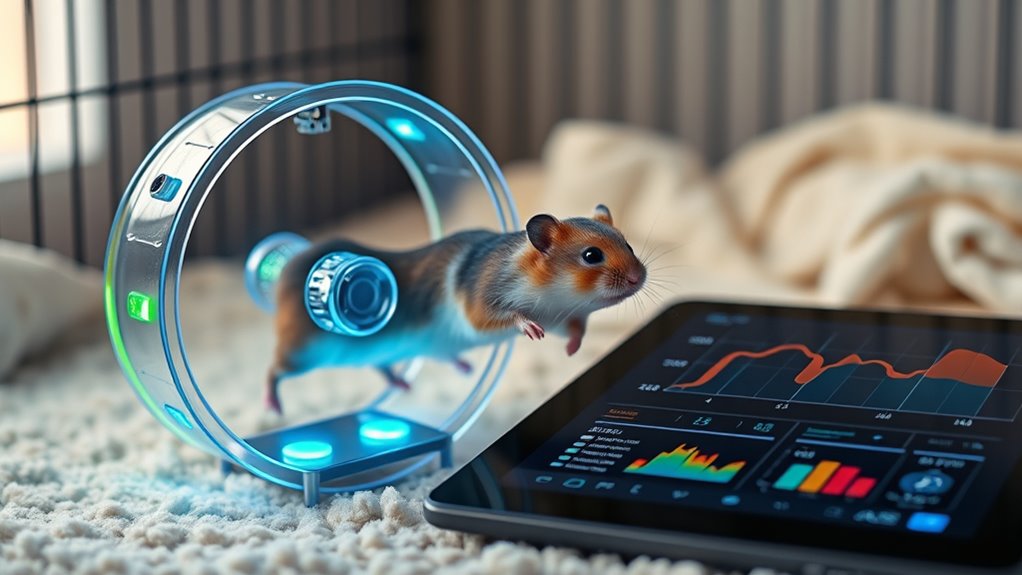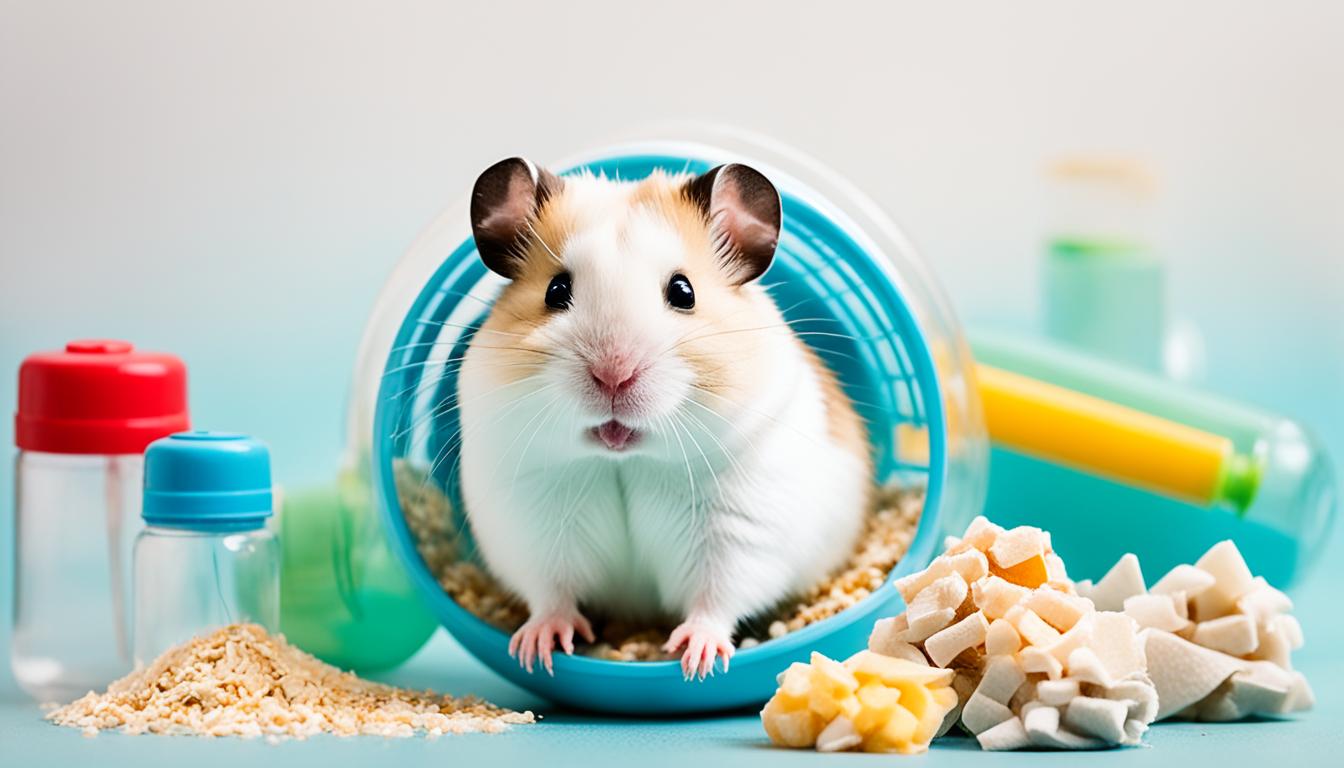Hamster smart wheels use wearable sensors to monitor your pet’s activity, like running speed, duration, and frequency. This data is wirelessly transmitted to a companion app, giving vets accurate, real-time insights into your hamster’s health. By tracking subtle changes, vets can detect health issues early and provide better care. If you keep exploring, you’ll discover how this technology can revolutionize small pet health monitoring and help ensure your hamster stays happy and healthy.
Key Takeaways
- Smart hamster wheels use sensors to track activity metrics like speed, duration, and frequency for health monitoring.
- Data from the wheels is wirelessly transmitted to apps, providing real-time insights into hamster activity patterns.
- Veterinarians can review objective activity data to diagnose health issues and assess overall wellness accurately.
- Continuous monitoring helps detect early signs of health problems or stress, enabling timely veterinary intervention.
- Future features may include additional sensors (heart rate, temperature) for comprehensive small pet health assessments.

Researchers have developed hamster smart wheels that actively collect data on your pet’s activity patterns. These innovative devices leverage wearable technology to monitor movement and behavior in real-time, providing valuable insights that were previously difficult to obtain. When your hamster runs on a smart wheel, sensors record various metrics such as speed, duration, and frequency of activity, all without disturbing your pet’s routine. This seamless data collection allows you and your veterinarian to understand your hamster’s health more precisely than ever before. The key advantage lies in the integration of wearable technology, which transforms a simple exercise wheel into a powerful health monitoring tool.
Hamster smart wheels use wearable tech to monitor activity, providing real-time health insights without disrupting routines.
Once the data is gathered, it undergoes detailed analysis to identify patterns, trends, and anomalies. This data analysis can reveal subtle changes in your hamster’s activity levels, which might indicate early signs of illness or stress. For example, a decrease in running time or a sudden drop in activity frequency could signal discomfort or health issues that require veterinary attention. Conversely, increased activity might indicate improved well-being or adaptation to new environments. By continuously collecting and analyzing this data, you’re empowered to make more informed decisions about your pet’s care, catching potential problems early before they become serious. Additionally, understanding grocery store hours can help pet owners plan errands around their pet monitoring routines to ensure they’re available for vet consultations if needed.
The wearable technology embedded in these smart wheels is designed to be non-intrusive and easy to install. You simply replace your current hamster wheel with the smart version, and it begins tracking automatically. The collected data is transmitted wirelessly to a companion app, where you can review activity summaries and detailed reports. This real-time feedback means you don’t have to wait for scheduled check-ups to learn about your hamster’s health status. Instead, you can monitor their activity patterns daily and share the information with your vet for more targeted advice.
Veterinarians also benefit from this technology, as it provides objective, quantitative data to support diagnoses. Instead of relying solely on visual observations or owner reports, they gain access to precise activity metrics that help assess overall health and detect early warning signs. This proactive approach can lead to quicker interventions and more personalized treatment plans, ultimately improving your hamster’s lifespan and quality of life. As wearable technology becomes more sophisticated, these smart wheels may soon incorporate additional sensors, like heart rate monitors or temperature sensors, further enhancing data analysis capabilities.
Frequently Asked Questions
How Accurate Is the Health Data Collected by the Smart Wheel?
You might wonder how accurate the health data from the smart wheel is. It’s quite reliable, but it depends on proper sensor calibration and consistent use. Keep in mind, data privacy is essential, so make certain that your device follows strict protocols to protect your information. While the sensors provide valuable insights, occasional calibration helps maintain precision, giving vets better data to monitor your health effectively.
Can the Smart Wheel Detect Specific Health Issues in Hamsters?
Imagine a tiny detective, silently watching your hamster’s every move. The smart wheel’s behavior monitoring can flag unusual activity, hinting at specific health issues. While it’s not a crystal ball, it helps vets spot patterns that signal problems. Environmental impact is minimized since data is gathered passively. You see, this clever device acts like a health detective, offering insights that keep your hamster happier and healthier.
Is the Smart Wheel Suitable for All Hamster Breeds?
You wonder if the smart wheel suits all hamster breeds. While it can track basic hamster behavior, its effectiveness depends on wheel size and design. You’ll need to customize the wheel to match your hamster’s breed, ensuring proper fit and comfort. Different breeds have unique activity levels, so wheel customization is key. This way, the smart wheel provides accurate data and keeps your hamster healthy and active regardless of its breed.
How Is the Data Transmitted and Stored Securely?
Imagine your data as a treasure chest. It’s transmitted through secure channels using wireless encryption, like a lock only you hold the key to. The data is stored in protected vaults with strict access controls, ensuring data privacy. This way, your health information stays safe from prying eyes, just like a treasure hidden away, accessible only to those with the right authorization, safeguarding your privacy at every turn.
What Is the Expected Lifespan of the Smart Wheel?
You might wonder about the device durability and battery life when considering the smart wheel. Typically, these devices are designed for durability, lasting several months to a year depending on usage. The battery life varies based on activity levels and data transmission frequency, but most smart wheels are built to withstand continuous use for a significant period. Regular maintenance and charging help make certain the device stays functional throughout its expected lifespan.
Conclusion
You can see how these smart wheels revolutionize pet care, giving vets real-time health insights. Did you know that hamsters using these wheels run up to 10% more than those without? That extra activity helps catch health issues early and improves their overall well-being. With this technology, you’re not just watching your pet; you’re actively helping them live healthier, happier lives. It’s a game-changer for both pet owners and veterinarians alike.










